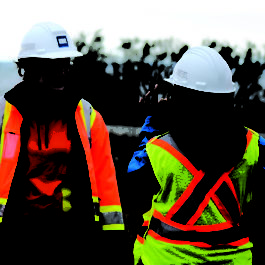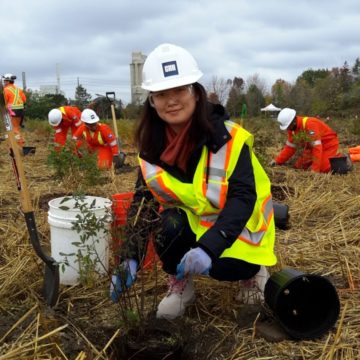CRH Canada Group & Credit Valley Conservation Authority: Flyway Restoration

Projects Sponsor
Flyway Habitat Restoration Project: Giving the birds, Credit. Credit Valley Conservation Authority and CRH Canada Group Inc. know waterfront property is for the birds.
It’s easy to be overwhelmed by the now indisputable fact that nature is declining at unprecedented rates globally. The obvious thing to feel when you read that 1,000,000 species are now threatened with extinction, many within our lifetime, is helpless, but as the Flyway Habitat Restoration Project clearly demonstrates, there’s another way to go.
The Flyway Habitat Restoration Project is the result of a partnership between CRH Canada Group Inc., Credit Valley Conservation (CVC), Environment and Climate Change Canada and CRH employees who volunteered their time, along with a lot of energetic nature lovers, some of them students, in Mississauga.
Biodiversity restoration and enhancement are at the forefront of CRH’s environmental priorities. The company looks upon their operations and surrounding areas as an opportunity to help restore and enhance the natural ecosystem, and as a chance to work with communities as they work to enhance the resilience of their built environments. The Flyway Habitat Restoration Project checked those boxes.
It was fortuitous that CVC had identified CRH’s waterfront property in Mississauga as a priority restoration area through their Terrestrial Ecosystem Enhancement Model: Landscape Scale Analysis for the City of Mississauga and CVC’s Lake Ontario Integrated Shoreline Strategy. These assessments are a direct response to priority restoration recommendations for waterfront properties and in 2015, CRH partnered with CVC and applied for funding under Environment and Climate Change Canada’s Habitat Stewardship Program for Species at Risk and got to work.
That is, they set out to restore 2.2 hectares of private land along Lake Ontario for migratory bird habitat.
Undertaking a large scale habitat restoration on private industrial lands in an area that is fully urbanized in order to provide high quality stopover habitat for migratory birds poses unique challenges. It is essential to engage both employees and the public which, through outreach and education, the partners were able to do.
Funding was secured—Environment and Climate Change Canada stepped up—and the project scope agreement, plan approval, implementation planning, planting, surveys, monitoring and inventories and project evaluation were put in place.
Care and precise planning were required to gain approval and the immense value of the land along the lakeshore presented its own obstacles to conservation, in part because biodiversity projects, unlike energy or GHG reduction projects are not easily measured and therefore the business case is not always as obvious.
The project was also delayed slightly due to some persistent invasive species that now plague Ontario. Additional rounds of invasive species removal were required prior to planting.
Project implementation was completed by CVC’s Terrestrial Ecosystem Restoration and Management team and through CRH’s 60 employee volunteers. The habitat restoration engaged CVC’s Conservation Youth Corps and the Biodiversity Institute of Ontario’s Barcode of Life project to do an insect survey.
To date, the team has not only removed invasive species, conducted insect and avian surveys, sponsored a showing of “The Messenger,” engaged employees, employee’s families, students and the community about the reality of species decline and biodiversity, they have seeded the grassland and meadow portion of the restoration and planted 1408 trees and shrubs.
Approximately 76% of the immediate land along Lake Ontario’s shoreline is urbanized; forest cover accounts for only 8% of the land cover. An individual bird survival rate during migration is much lower than its survival rate when on their breeding or wintering ground, with an estimated 50% chance of survival during migration. The Flyway provides essential habitat for migratory birds and pollinators.
The first kilometer of land around Lake Ontario is important for migratory landbirds that need to refuel after the long journey over or around Lake Ontario. Birds that stop along the northern shoreline of Lake Ontario are at risk due to poor habitat quality.
By using a variety of native species at varying heights, this newly restored well-structured and diverse habitat will increase insect diversity which will provide high protein food and increase the abundance and variety of berries and seeds to provide fats and other nutrients and expand the amount of good cover so birds can be protected from predators and the elements.
To date, biodiversity efforts at CRH’s Mississauga Plant combine for 297 plus employee volunteer hours during work time, 52 native species introduced and 2976 trees, shrubs and herbaceous plants planted. A young tree can sequester approximately 13 lbs of carbon in a year. That’s good for all of us but with their work on the Flyway Habitat Restoration Project, the Credit Valley Conservation Authority and CRH Canada Group Inc. have truly done something concrete for the birds.




















